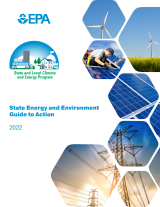Energy and Environment Guide to Action
A Guide to State Policy Innovations that Deliver Climate and Energy Benefits

Overview:
- Offers real-world best practices to help states design and implement policies that reduce emissions associated with electricity generation and energy consumption.
- Helps state officials leverage other states' policy innovations and implementation experiences to achieve their own climate, energy, and environmental goals.
About the Guide:
Each Guide chapter covers a unique policy topic, provides descriptions and a regulatory landscape of the featured policy, explains its environmental, energy, and health benefits, highlights how states have approached key design and implementation issues, and shares best practices based on state experiences.
We are currently updating the Guide in phases, with each updated chapter reflecting significant state regulatory and policy developments since the Guide's prior publication in 2015.
Access the content:
Here are seven updated chapters on key utility policies that states can pursue to support clean energy and energy efficiency:
Overview of the U.S. power system, the roles of utility and environmental regulators, and themes across the Guide to Action's utility policy chapters.
Integrated resource plans and other planning pathways states are using to achieve environmental goals, primarily through the incorporation of supply- and demand-side clean energy resources like renewable and energy efficiency.
Frameworks to remove disincentives for investment in distributed energy resources (DERs) and reward utilities for achievements in system operations, energy services, and other objectives aligned with broader policy goals.
State experience using interconnection standards and net metering policies to facilitate or encourage the adoption of DERs, such as rooftop solar voltaic, energy storage, and combined heat and power.
Setting utility rates and increasing access to customer energy use information to enable customers to use energy more efficiently and adopts DERs that reduce that reduce emissions and provide other benefits.
State opportunities to modernize their electrical distribution systems via one or more of the following: (1) improved distribution system efficiency; (2) clean energy integration; and (3) enhanced grid planning paradigms.
Customer-funded energy efficiency programs and energy efficiency resource standards, especially recent updates that set out to reach climate change and air quality objectives.
Future chapters:
Forthcoming chapter updates will include appliance standards, clean generation requirements, and lead by example policies, among others.
Please sign up to be notified when future chapters are released.
